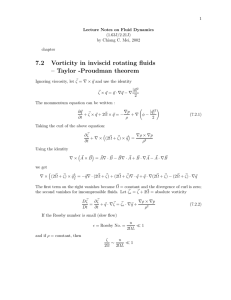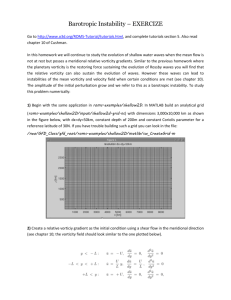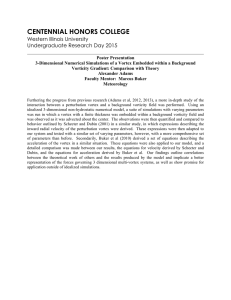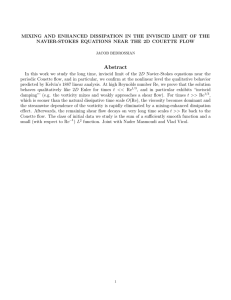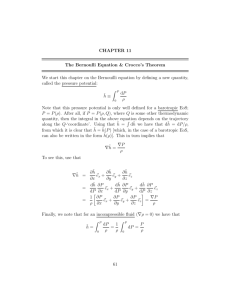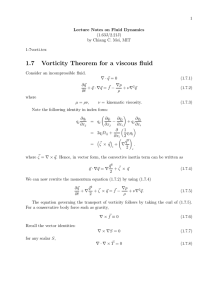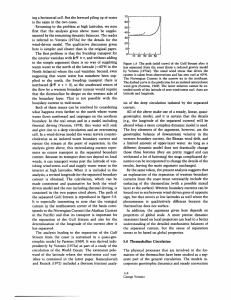Final Review 1 Conservation Relations in Lagrangian form 2
advertisement
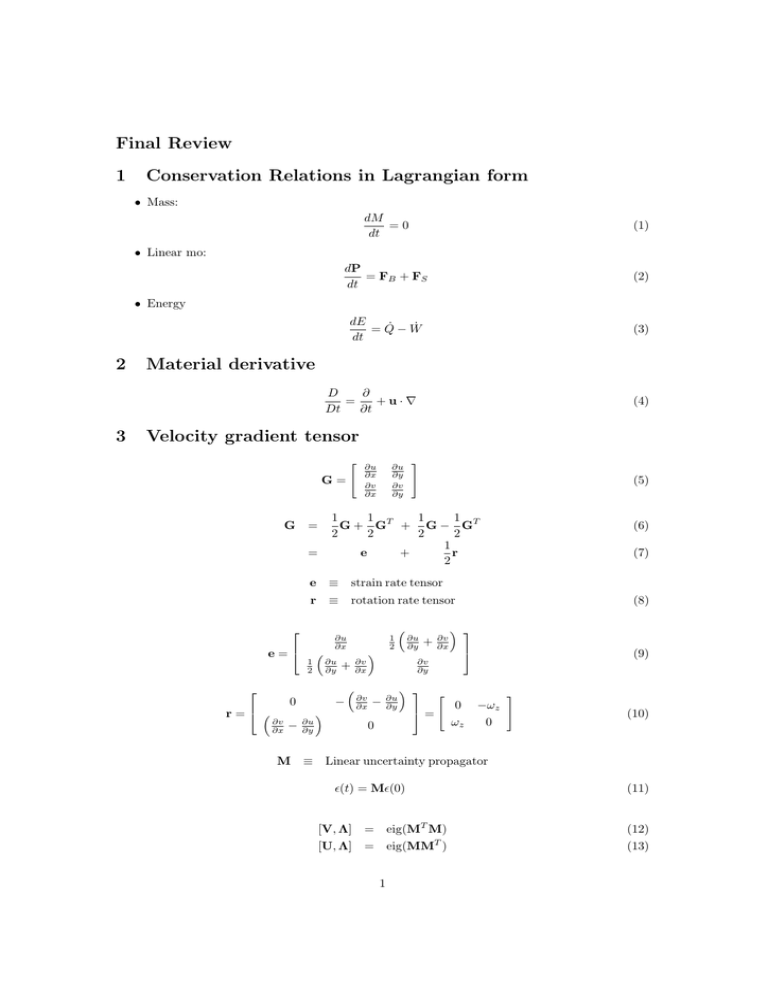
Final Review 1 Conservation Relations in Lagrangian form • Mass: dM =0 dt (1) dP = FB + FS dt (2) dE = Q̇ − Ẇ dt (3) • Linear mo: • Energy 2 Material derivative D ∂ = +u·∇ Dt ∂t 3 (4) Velocity gradient tensor G= G ∂u ∂y ∂v ∂y ∂u ∂x ∂v ∂x (5) 1 1 1 1 G + GT + G − GT 2 2 2 2 1 e + r 2 = = (6) (7) e ≡ strain rate tensor r ≡ rotation rate tensor ⎡ e=⎣ ⎡ r=⎣ 1 2 0 ∂v ∂x − ∂u ∂y ∂u ∂x ∂u ∂y + − ∂v ∂x ∂v ∂x 1 2 ∂u ∂y ∂v ∂x + (8) ⎤ ⎦ (9) ∂v ∂y − ∂u ∂y ⎤ ⎦= 0 0 ωz −ωz 0 (10) M ≡ Linear uncertainty propagator (t) = M(0) (11) [V, Λ] = eig(MT M) [U, Λ] = eig(MM ) T 1 (12) (13) Figure 1: (fig:ReviewLinUncerProp) Linear uncertainty propagator. 4 Reynolds Transport Theorem ∂c dC d c dV = c u · dA = dV + dt dt ∂t V V (14) A ≡ extensive (sum of parts) C c ≡ intensive (stuff per volume) 5 Divergence (or Gauss) Theorem ∇ · Q dV = V Q · dA (15) A Divergence on left, flux on right. 6 Another form of the RTT dC dt 7 = ∂c + ∇ · (c u) dV ∂t (16) V Yet Another form of the RTT dC dt = Dc + c∇ · u dV Dt (17) V (18) Use of RTT to go from Lagrange conservation laws (e.g. 8 dM dt = 0) to Eulearian (e.g. Dρ Dt +ρ∇·u = 0) Continuity No approximation: Dρ + ρ∇ · u = 0 Dt (19) ∇·u=0 (20) ∇·u=0 (21) Boussinesq: Euler (but can have compressible Euler): 2 9 Momentum No approximation: ρ Du Dt = ρg − ∇p + µ∇2 u + µ ∇(∇ · u) 3 (22) Boussinesq: ρ0 Du Dt = ρ g − ∇p + µ∇2 u (23) Euler: ρ 10 Du Dt = ρg − ∇p (24) Heat No approximation: (Jim – There are a couple approximations in there ;) ρcv DT Dt = −p(∇ · u) + φ − ∇ · q (25) Boussinesq: Dt Dt 11 k 2 ∇ T pcp = (26) State Atmosphere: p = ρRT (27) Ocean: ρ = ρ0 (1 − λT (T − T0 ) + λ0 (S − S0 )) DS = f ∇2 S Dt 12 (28) (29) Entropy No approximation and Boussinesq: µ > 0, k > 0 13 (30) Bernoulli • Steady Flow (inviscid barotropic) 1 dp u · u + gz + = 2 ρ constant along streamlines and vortex lines 3 (31) • Steady irrotational flow (inviscid barotropic): 1 dp u · u + gz + = 2 ρ constant everywhere (32) • Irrotational flow (inviscid barotropic): ∂φ 1 + u · u + gz + ∂t 2 dp ρ u = ∇φ (33) (34) Remember, ∇ · u ⇒ ∇ · ∇φ = 0 ⇒ ∇2 φ = 0. 14 Solid body rotation uθ ωz = Ω0 r = 2Ω0 Λ = ωz πr2 15 16 (35) (36) (37) Point Vortex uθ = ωz = Γ 2πr 0 (Except at location of point vortex) (38) (39) Circulation Γ= u · ds (40) (∇ × u) · dA (41) c 17 Stoke’s Theorem u · ds = c 18 A Kelvin’s circulation theorem (non-rotating) DΓ =0 Dt Inviscid, barotropic, only conservative body forces. 4 (42) 19 Helmholtz vortex theorems 1. Vortex lines move with the fluid 2. Circulation of a vortex tube is constant along its length 3. A vortex tube can only end at a solid boundary, or form a closed loop 4. The circulation of a vortex tube is constant in time 20 Vorticity equation (non-rotating) Incompressible, barotropic: Dω Dt = ω · ∇u + ν∇2 ω (43) Incompressible, baroclinic: Dω Dt 21 1 ∇ρ × ∇p + ν∇2 ω ρ2 (44) Rotating frame uf ixed af ixed 22 = ω · ∇u + = urot + Ω × r = arot + 2Ω × urot + Ω × (Ω × r) = arot + 2Ω × urot − Ω2 R (45) (46) (47) Momentum equation (rotating) Du Dt ν 1 = − ∇p + (g + Ω2 R) − 2Ω × u + ν∇2 u + ∇(∇ · u) p 3 ν 1 = − ∇p − g − 2Ω × u + ν∇2 u + ∇(∇ · u) p 3 (48) (49) Centrifugal force sucked into gravity term. 23 Coriolis force • Turns stuff to the right (N.H.) • Does no work 24 Vorticity equation (rotating earth-centric coordinates) Dω 1 = (ω + 2Ω) · ∇u + 2 ∇ρ × ∇p + ν∇2 ω Dt ρ 5 (50) 25 Kelvin’s circulation theorem (rotating) DΓa = 0, Dt 26 (ω + 2Ω) · dA Γa = (51) A Simplified momentum equations 1 ∂p ∂2u + fv + ν 2 ρ ∂x ∂z 1 ∂p ∂2v = − − fu + ν 2 ρ ∂y ∂z 1 ∂p 0 = − −g ρ ∂z Du Dt Dv Dt = − (52) (53) (54) Know scaling arguments that got us here. 27 Inviscid, simplified momentum equations Du Dt Dv Dt 1 ∂p + fv ρ ∂x 1 ∂p = − − fu ρ ∂y ∂p 0 = − − pg ∂z 28 = − (57) (58) β plane approximation f = f0 + βy = 2Ω sin φ0 + 30 (56) f plane approximation f = f0 = 2Ω sin φ0 29 (55) 2Ω cos φ0 y r (59) Balances and flows from simplified, inviscid mo. eq. 1. Inertial oscillations: − u2θ = f uθ r 1 p 1 p ∂p ∂x ∂p ∂y (60) 2. Geostrophy 6 = fv (61) = −f u (62) 3. Gradient wind (can be less than or greater than geostrophic wind): − u2θ r uθ 1 ∂p + f uθ p ∂r 1 ∂p = f (R0 , 2 , ) ρf r ∂r = − (63) (64) • Describes cyclonic/anticyclonic highs/lows • High pressure ∂p ∂r less than low pressure ∂p ∂r • High pressure systems have gentle winds in center 4. Cyclostrophic wind u2θ 1 ∂p = r ρ ∂r (65) 5. Isallobaric wind u 31 ∂u ∂x ∂u ∂t = fv (66) = fv (67) 1 ∂p − f v − νH ∇2 u = 0 ρ ∂x (68) Geostrophy plus friction Three way balance, cross-isobaric flow. 32 Balances and flows from simplified vorticity equation • Taylor-Proudman (barotropic): 2Ω · ∇u = 0 ∂u ∂v ⇒ = =0 ∂z ∂z ⇒ vertical rigidity (69) (70) (71) • Thermal wind (baroclinic): 1 ∇ρ × ∇p = 0 ρ2 ∂u g ⇒ = − k × ∇ρ ∂z fρ ∂u gρ0 α ⇒ = k × ∇T ∂z fρ 2Ω · ∇u + This last step was made based on the relationship between p and T . 7 (72) (73) (74) 33 Ekman Layer • Non-rotating boundary layers grow, Ekman layer does not. • Mass transport: τ ×k f (75) 1 ∇×τ ·k ρf (76) MEk = • Ekman spiral • Ekman pumping and suction WEk = 34 Sverdrup Transport • Explained using Kelvin’s circulation theorem: (Jim – You appear to have two ρ in your notes) v= 1 (∇ × τ ) · k hρ (77) • Wind-driven circulation sensitive to curl of wind stress • Return flow in the western boundary current 35 Shallow water equations Du Dt Dv Dt ∂h ∂t 36 ∂h + fv ∂x ∂h = −g − fu ∂y ∂u ∂v =0 + h + ∂x ∂y = −g (78) (79) (80) Wave kinematics k= • Phase speed = • Group speed = 2π , λx l= 2π , λy ω= 2π T (81) ω k ∂ω ∂k (carries information). • Dispersion relation relates ω, k, l, and provides graphical information about phase and group speed. 8 Figure 2: (fig:ReviewWaveDispRel) Wave dispersion relationship. Positive slope means positive group speed. Negative slope means negative group speed. Slope of line connecting a point on the curve to the origin gives phase speed. 37 Shallow water potential vorticity equation D Dt ωz + f h =0 (82) Obtained from cross-differentiating, subtracting and simplifying the shallow water equations. Note: D fixed depth barotropic vorticity equation is Dt (ωz + f ) = 0. 38 Potential vorticity ωz + f = constant h Potential vorticity is conserved following the flow. “Flow over a mountain” example. 39 (83) Shallow water gravity waves without rotation • Obtained from non-rotating shallow water equations • ω = g h̄K = cK • Non-dispersive 40 Inertia-gravity waves • Obtained from rotating shallow water equations • ω = 0, ± f02 + c2 K 2 • Dispersive, except in limit of large K • Behave like non-rotating gravity waves at large K, ω = cK • Behave like inertial oscillations at small k, ω = f0 41 Kelvin waves • Obtained from rotating shallow water equations with v = 0 (transverse velocity) and a lateral boundary • ω = cK • Non-dispersive 9 42 Constant depth, barotropic Rossby waves D • Obtained from barotropic vorticity equation ( Dt (ωz + f ) = 0) • Dispersion relationship (see figure): ω=− βk k 2 + l2 (84) • Dispersive • Phase and group speeds can be in opposite directions Figure 3: (fig:ReviewBarotropicRossWave) Constant depth, barotropic Rossby wave dispersion relationship. 43 Shallow water Rossby waves • Obtained from conservation of potential vorticity • ω = − k2 +lβk 2+ 1 R2 d , Rd = C f0 • Dispersive • Phase and group speeds can be in opposite directions • Rd sets a length scale that forces a maximum phase speed Figure 4: (fig:ReviewShallowWaterRossWave) Shallow water Rossby wave dispersion relationship. 10
